EX-99.1
Published on April 14, 2023

The PNC Financial Services Group First Quarter 2023 Earnings Conference Call April 14, 2023 Exhibit 99.1
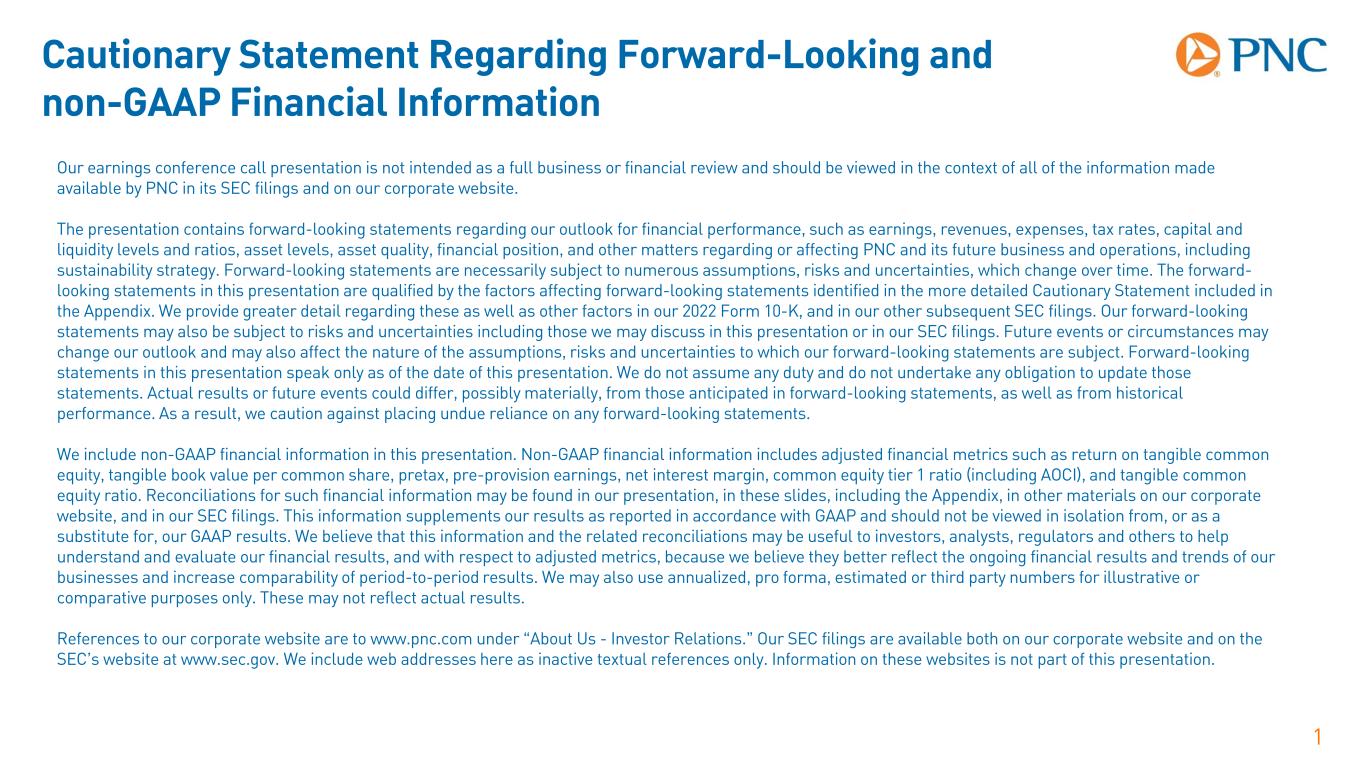
Cautionary Statement Regarding Forward-Looking and non-GAAP Financial Information Our earnings conference call presentation is not intended as a full business or financial review and should be viewed in the context of all of the information made available by PNC in its SEC filings and on our corporate website. The presentation contains forward-looking statements regarding our outlook for financial performance, such as earnings, revenues, expenses, tax rates, capital and liquidity levels and ratios, asset levels, asset quality, financial position, and other matters regarding or affecting PNC and its future business and operations, including sustainability strategy. Forward-looking statements are necessarily subject to numerous assumptions, risks and uncertainties, which change over time. The forward- looking statements in this presentation are qualified by the factors affecting forward-looking statements identified in the more detailed Cautionary Statement included in the Appendix. We provide greater detail regarding these as well as other factors in our 2022 Form 10-K, and in our other subsequent SEC filings. Our forward-looking statements may also be subject to risks and uncertainties including those we may discuss in this presentation or in our SEC filings. Future events or circumstances may change our outlook and may also affect the nature of the assumptions, risks and uncertainties to which our forward-looking statements are subject. Forward-looking statements in this presentation speak only as of the date of this presentation. We do not assume any duty and do not undertake any obligation to update those statements. Actual results or future events could differ, possibly materially, from those anticipated in forward-looking statements, as well as from historical performance. As a result, we caution against placing undue reliance on any forward-looking statements. We include non-GAAP financial information in this presentation. Non-GAAP financial information includes adjusted financial metrics such as return on tangible common equity, tangible book value per common share, pretax, pre-provision earnings, net interest margin, common equity tier 1 ratio (including AOCI), and tangible common equity ratio. Reconciliations for such financial information may be found in our presentation, in these slides, including the Appendix, in other materials on our corporate website, and in our SEC filings. This information supplements our results as reported in accordance with GAAP and should not be viewed in isolation from, or as a substitute for, our GAAP results. We believe that this information and the related reconciliations may be useful to investors, analysts, regulators and others to help understand and evaluate our financial results, and with respect to adjusted metrics, because we believe they better reflect the ongoing financial results and trends of our businesses and increase comparability of period-to-period results. We may also use annualized, pro forma, estimated or third party numbers for illustrative or comparative purposes only. These may not reflect actual results. References to our corporate website are to www.pnc.com under “About Us - Investor Relations.” Our SEC filings are available both on our corporate website and on the SEC’s website at www.sec.gov. We include web addresses here as inactive textual references only. Information on these websites is not part of this presentation. 1
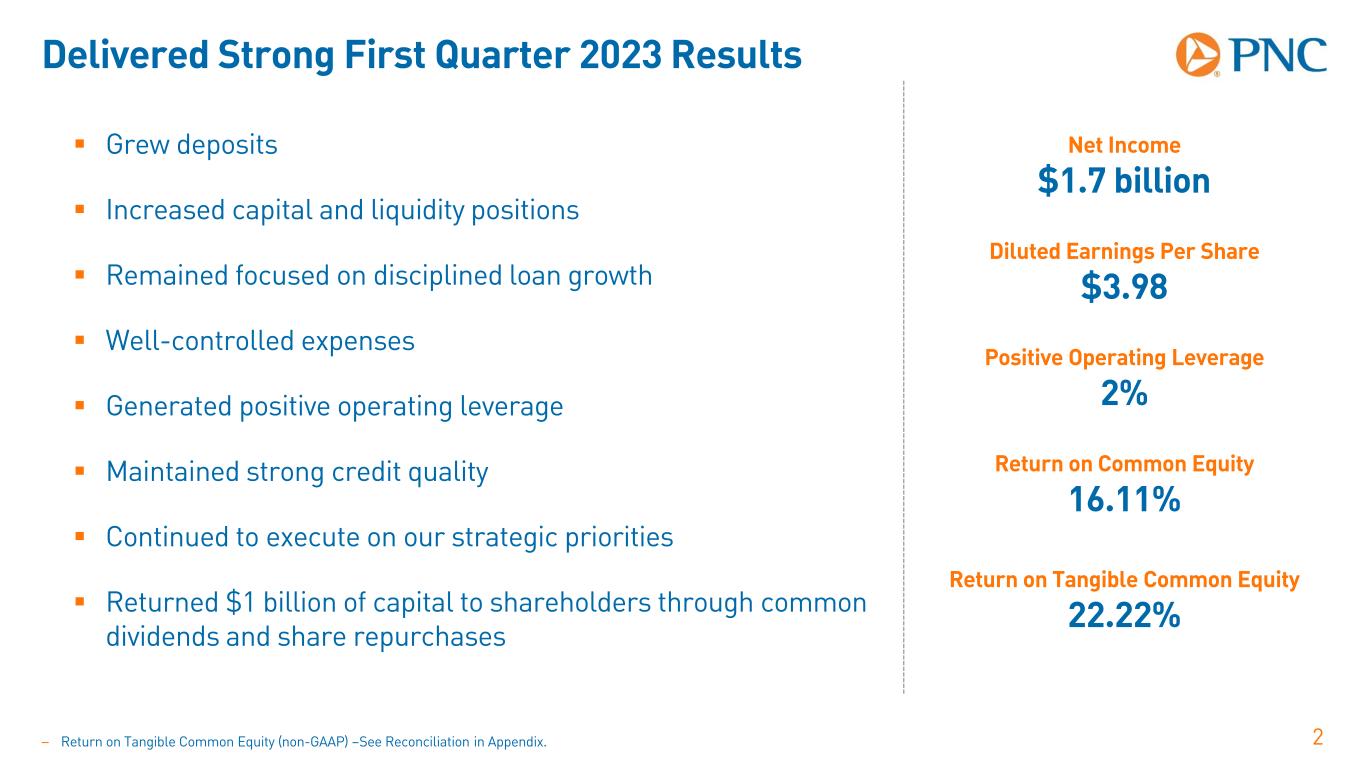
Delivered Strong First Quarter 2023 Results 2 Grew deposits Increased capital and liquidity positions Remained focused on disciplined loan growth Well-controlled expenses Generated positive operating leverage Maintained strong credit quality Continued to execute on our strategic priorities Returned $1 billion of capital to shareholders through common dividends and share repurchases Net Income $1.7 billion Diluted Earnings Per Share $3.98 Return on Common Equity 16.11% – Return on Tangible Common Equity (non-GAAP) –See Reconciliation in Appendix. Return on Tangible Common Equity 22.22% Positive Operating Leverage 2%
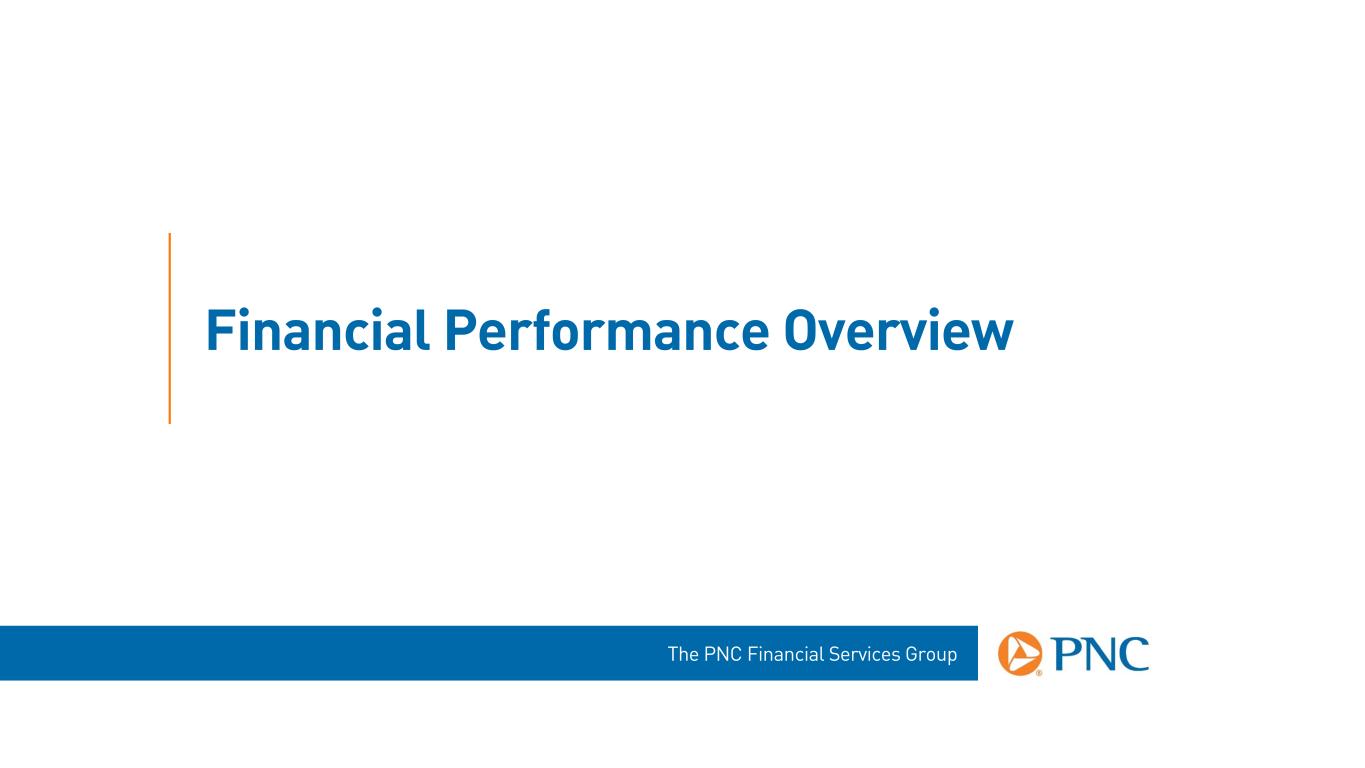
The PNC Financial Services Group Financial Performance Overview

Balance Sheet: Well-Positioned Balance Sheet 4 1Q23 vs. 4Q22 1Q23 vs. 1Q22 Average balances, $ billions 1Q23 $ Change % Change $ Change % Change Total loans $325.5 $3.6 1% $34.8 12% Investment securities $143.4 $0.5 -- $9.5 7% Federal Reserve Bank (FRB) balances $33.5 $3.5 12% ($28.8) (46)% Deposits $436.2 $1.3 -- ($17.1) (4)% Borrowed funds $63.0 $3.8 6% $32.7 108% Common shareholders’ equity $40.5 $1.1 3% ($6.9) (15)% Period End 1Q23 4Q22 1Q23 vs. 4Q22 1Q22 1Q23 vs. 1Q22 Basel III common equity Tier 1 (CET1) capital ratio 9.2% 9.1% 10 bps 9.9% (70) bps Tangible book value per common share (non-GAAP) $76.90 $72.12 7% $79.68 (3)% AOCI ($ in billions) ($9.1) ($10.2) 10% ($5.7) (59)% Return on average common equity 16.11% 14.19% 192 bps 11.64% 447 bps − Basel III common equity Tier 1 capital ratio – March 31, 2023 ratio is estimated. Details of the calculation are in the capital ratios table in the financial highlights section of the earnings release. − Tangible book value per common share (non-GAAP) – See reconciliation in Appendix. − AOCI represents accumulated other comprehensive income.

Balance Sheet: Loans Core Funded with Deposits 5 Av er ag e ba la nc es , $ b ill io ns Grew Average Loans Disciplined Loan Growth $95.1 $100.3 $100.9 $195.6 $221.6 $224.6 $290.7 $321.9 $325.5 3.19% 4.75% 5.29% 1Q22 4Q22 1Q23 Consumer Commercial Loan Yield $299.5 $301.4 $315.1 $153.7 $133.5 $121.2 $453.3 $434.9 $436.2 0.04% 1.07% 1.66% 1Q22 4Q22 1Q23 Grew Average Deposits Linked Quarter Strong Core Deposit Base Av er ag e ba la nc es , $ b ill io ns − IB Deposits represent interest-bearing deposits and NIB Deposits represent noninterest-bearing deposits. − Totals may not sum due to rounding. Rate Paid on IB DepositsNIB DepositsIB Deposits

Income Statement: Solid Performance 6− Pretax, pre-provision earnings (non-GAAP) –See Reconciliation in Appendix. − Net interest margin is calculated using taxable-equivalent net interest income, a non-GAAP measure, a reconciliation of which is provided in the Appendix. % Change 1Q23 vs. $ millions 1Q23 4Q22 1Q22 4Q22 1Q22 Net interest income $3,585 $3,684 $2,804 (3)% 28% Noninterest income 2,018 2,079 1,888 (3)% 7% Total revenue 5,603 5,763 4,692 (3)% 19% Noninterest expense 3,321 3,474 3,172 (4)% 5% Pretax, pre-provision earnings (non-GAAP) $2,282 $2,289 $1,520 -- 50% Provision for credit losses $235 $408 ($208) n / m n / m Income taxes $353 $333 $299 6% 18% Net income $1,694 $1,548 $1,429 9% 19% 1Q23 4Q22 1Q22 1Q23 vs. 4Q22 1Q23 vs. 1Q22 Noninterest income to total revenue 36% 36% 40% -- (400) bps Net interest margin (non-GAAP) 2.84% 2.92% 2.28% (8) bps 56 bps Diluted EPS $3.98 $3.47 $3.23 15% 23%
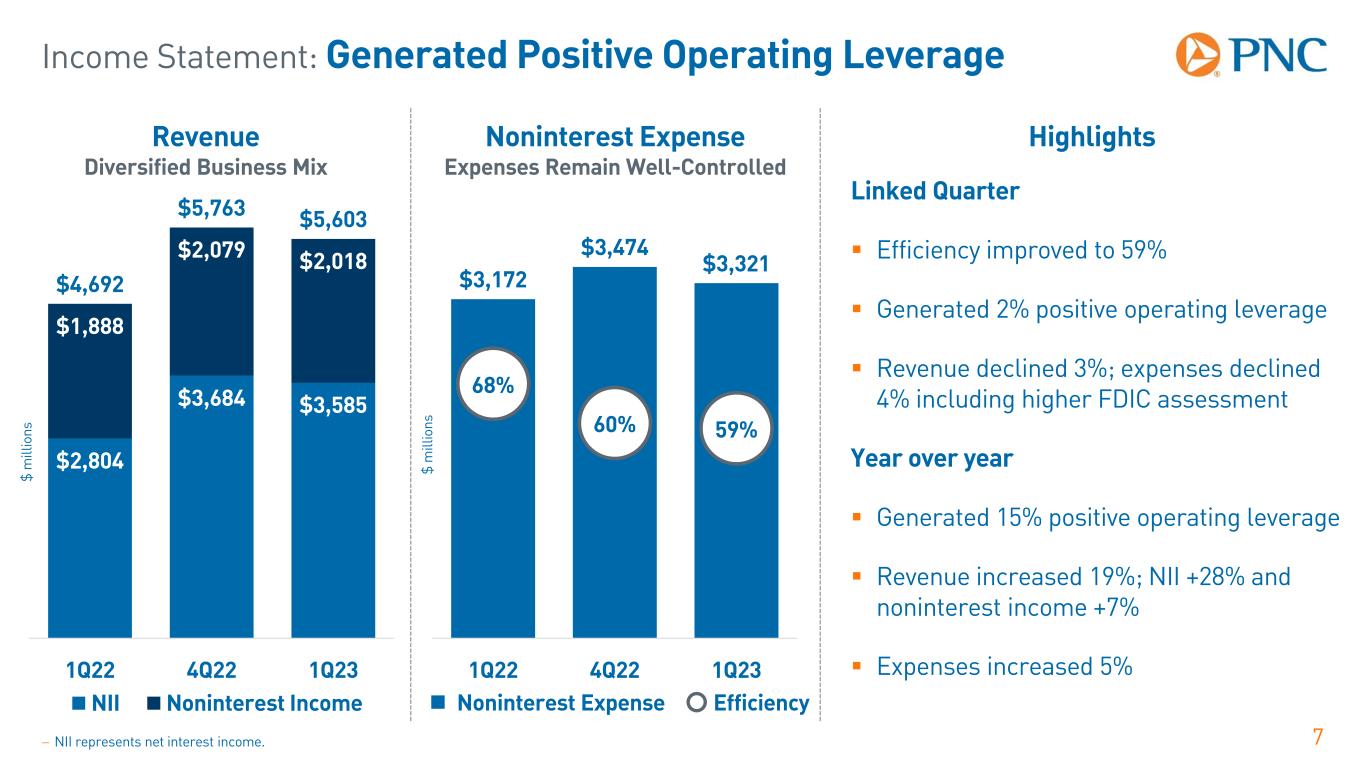
Income Statement: Generated Positive Operating Leverage 7 $ m ill io ns Revenue Diversified Business Mix $2,804 $3,684 $3,585 $1,888 $2,079 $2,018 $4,692 $5,763 $5,603 1Q22 4Q22 1Q23 NII Noninterest Income $3,172 $3,474 $3,321 68% 60% 59% 1Q22 4Q22 1Q23 Noninterest Expense Expenses Remain Well-Controlled $ m ill io ns Highlights Linked Quarter Efficiency improved to 59% Generated 2% positive operating leverage Revenue declined 3%; expenses declined 4% including higher FDIC assessment Year over year Generated 15% positive operating leverage Revenue increased 19%; NII +28% and noninterest income +7% Expenses increased 5% − NII represents net interest income. EfficiencyNoninterest Expense
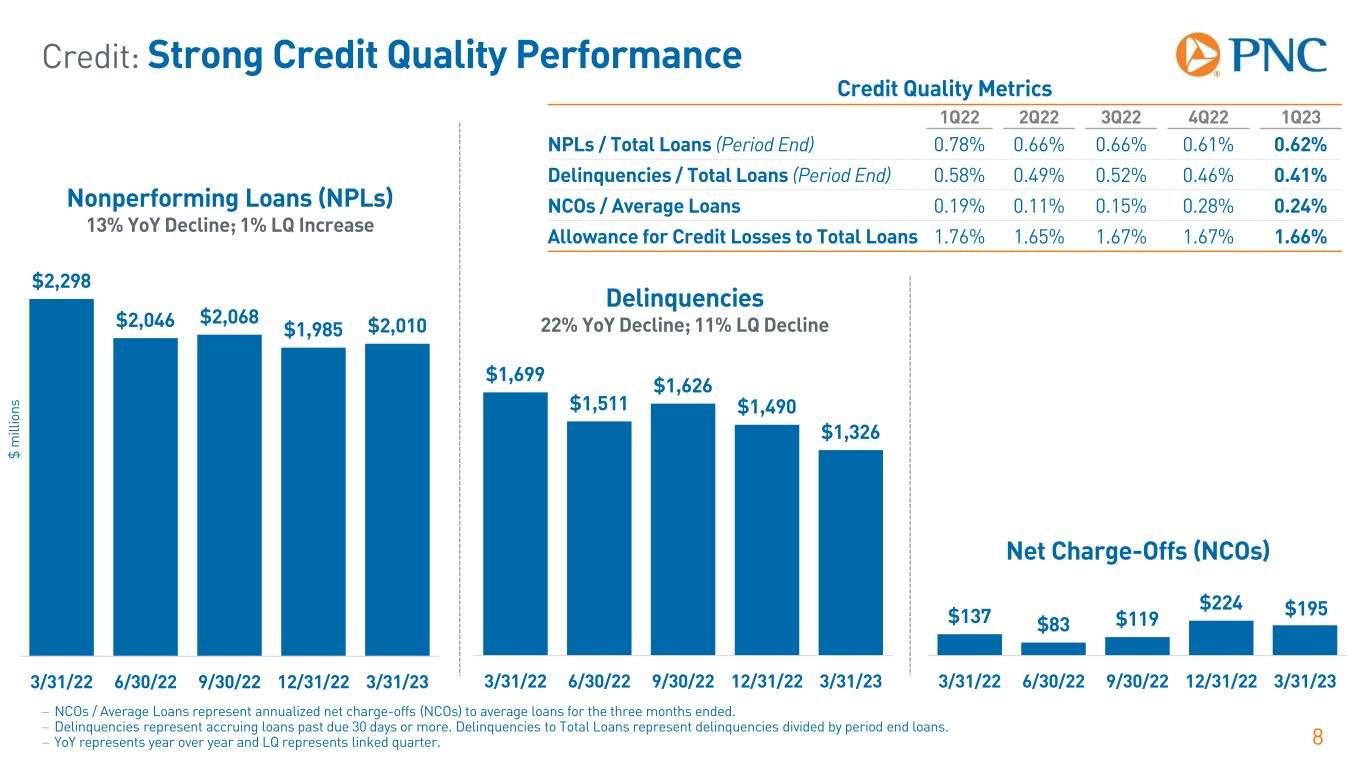
Credit: Strong Credit Quality Performance 8 − NCOs / Average Loans represent annualized net charge-offs (NCOs) to average loans for the three months ended. − Delinquencies represent accruing loans past due 30 days or more. Delinquencies to Total Loans represent delinquencies divided by period end loans. − YoY represents year over year and LQ represents linked quarter. $1,699 $1,511 $1,626 $1,490 $1,326 3/31/22 6/30/22 9/30/22 12/31/22 3/31/23 $2,298 $2,046 $2,068 $1,985 $2,010 3/31/22 6/30/22 9/30/22 12/31/22 3/31/23 Nonperforming Loans (NPLs) 13% YoY Decline; 1% LQ Increase Delinquencies 22% YoY Decline; 11% LQ Decline Net Charge-Offs (NCOs) $195$137 $83 $119 $224 3/31/22 6/30/22 9/30/22 12/31/22 3/31/23 Credit Quality Metrics 1Q22 2Q22 3Q22 4Q22 1Q23 NPLs / Total Loans (Period End) 0.78% 0.66% 0.66% 0.61% 0.62% Delinquencies / Total Loans (Period End) 0.58% 0.49% 0.52% 0.46% 0.41% NCOs / Average Loans 0.19% 0.11% 0.15% 0.28% 0.24% Allowance for Credit Losses to Total Loans 1.76% 1.65% 1.67% 1.67% 1.66% $ m ill io ns
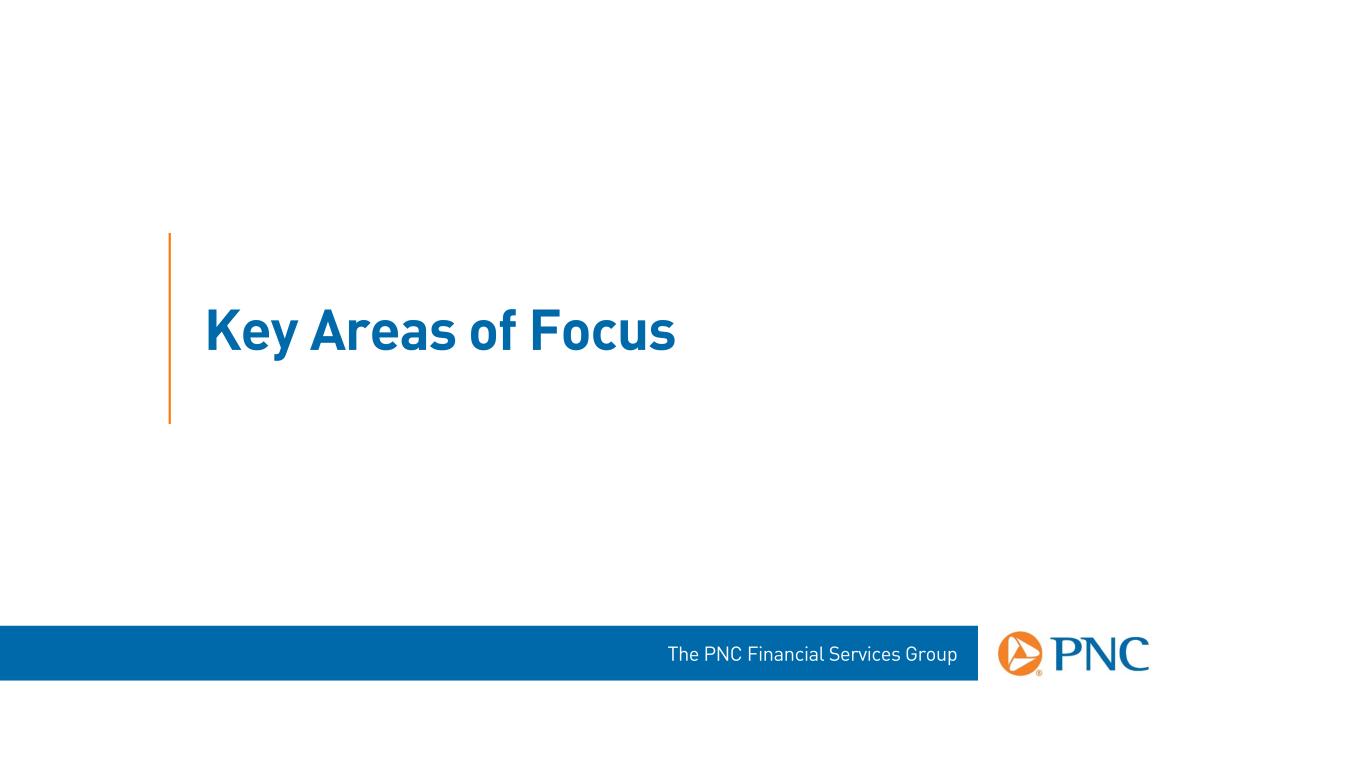
The PNC Financial Services Group Key Areas of Focus
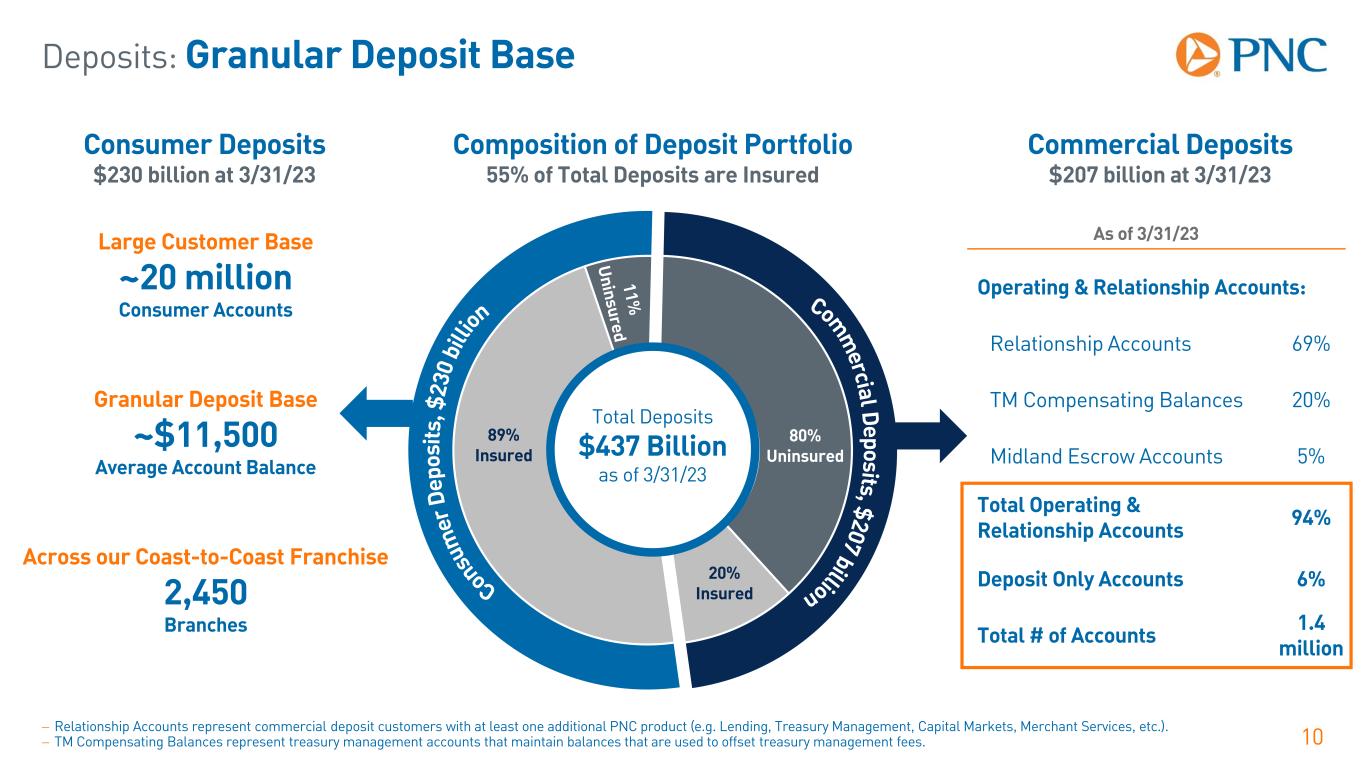
Deposits: Granular Deposit Base 10 Composition of Deposit Portfolio 55% of Total Deposits are Insured Total Deposits $437 Billion as of 3/31/23 Commercial Deposits $207 billion at 3/31/23 89% Insured 20% Insured 80% Uninsured Consumer Deposits $230 billion at 3/31/23 Granular Deposit Base ~$11,500 Average Account Balance Large Customer Base ~20 million Consumer Accounts Across our Coast-to-Coast Franchise 2,450 Branches − Relationship Accounts represent commercial deposit customers with at least one additional PNC product (e.g. Lending, Treasury Management, Capital Markets, Merchant Services, etc.). − TM Compensating Balances represent treasury management accounts that maintain balances that are used to offset treasury management fees. As of 3/31/23 Operating & Relationship Accounts: Relationship Accounts 69% TM Compensating Balances 20% Midland Escrow Accounts 5% Total Operating & Relationship Accounts 94% Deposit Only Accounts 6% Total # of Accounts 1.4 million
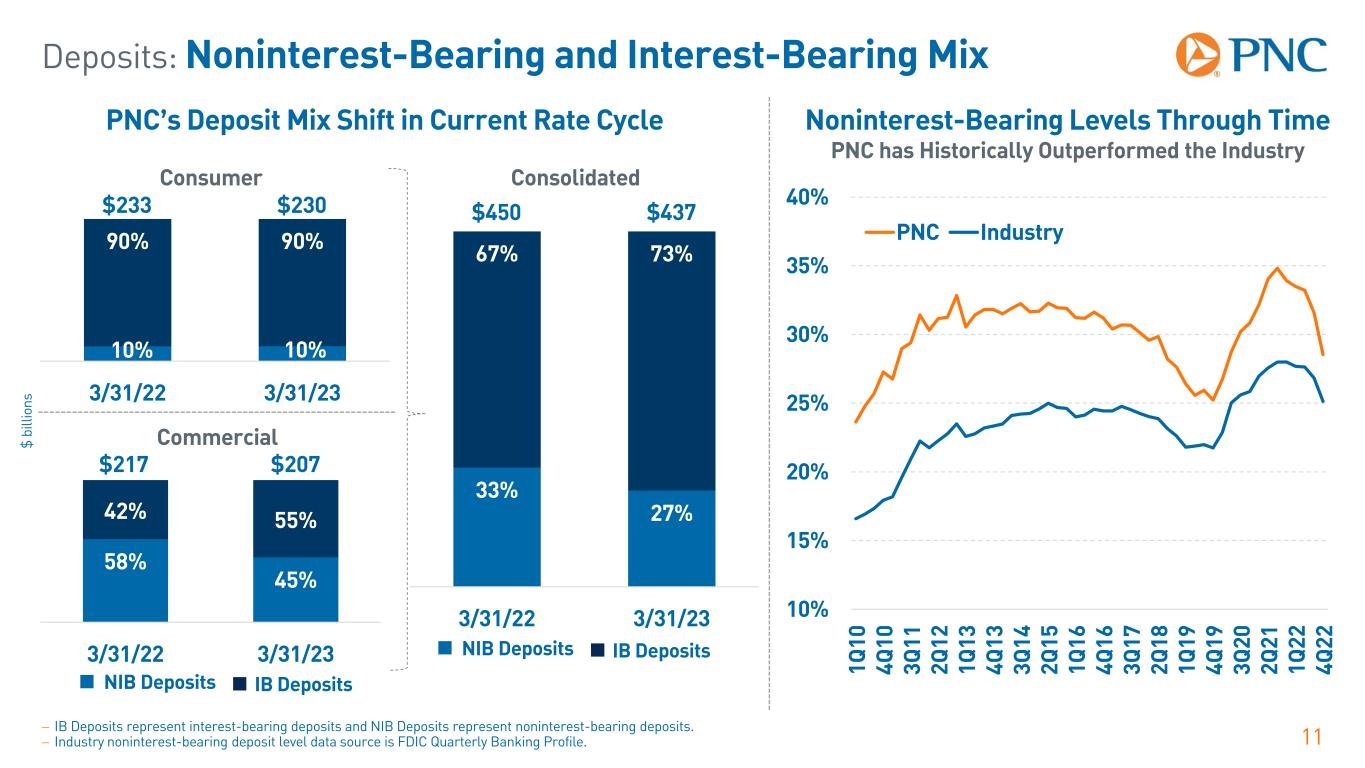
Deposits: Noninterest-Bearing and Interest-Bearing Mix 11 Noninterest-Bearing Levels Through Time PNC has Historically Outperformed the Industry − IB Deposits represent interest-bearing deposits and NIB Deposits represent noninterest-bearing deposits. − Industry noninterest-bearing deposit level data source is FDIC Quarterly Banking Profile. 10% 15% 20% 25% 30% 35% 40% 1Q 10 4Q 10 3Q 11 2Q 12 1Q 13 4Q 13 3Q 14 2Q 15 1Q 16 4Q 16 3Q 17 2Q 18 1Q 19 4Q 19 3Q 20 2Q 21 1Q 22 4Q 22 PNC Industry PNC’s Deposit Mix Shift in Current Rate Cycle 10% 10% 90% 90% 3/31/22 3/31/23 58% 45% 42% 55% 3/31/22 3/31/23 Consumer Commercial Consolidated 33% 27% 67% 73% 3/31/22 3/31/23 IB DepositsNIB Deposits IB DepositsNIB Deposits $233 $230 $217 $207 $450 $437 $ bi lli on s
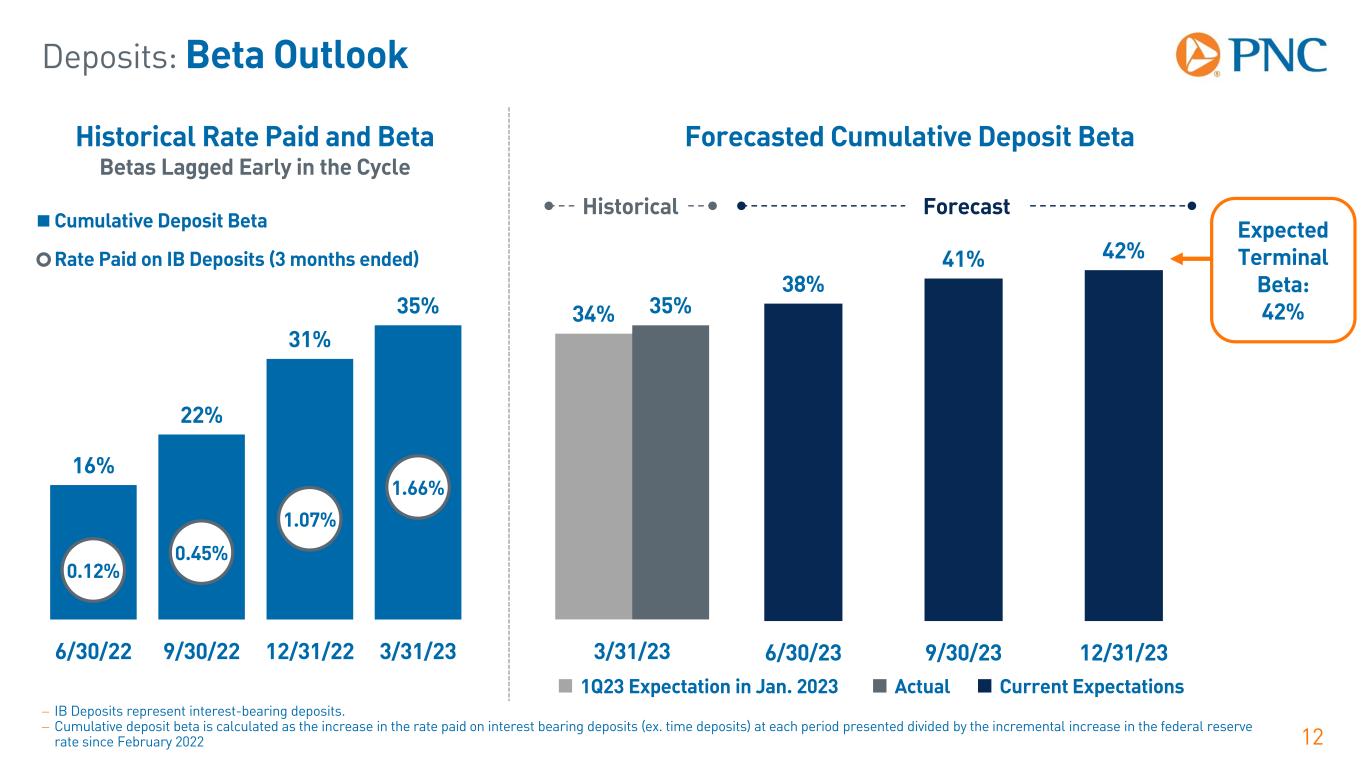
Deposits: Beta Outlook 12 Historical Rate Paid and Beta Betas Lagged Early in the Cycle Forecasted Cumulative Deposit Beta − IB Deposits represent interest-bearing deposits. − Cumulative deposit beta is calculated as the increase in the rate paid on interest bearing deposits (ex. time deposits) at each period presented divided by the incremental increase in the federal reserve rate since February 2022 16% 22% 31% 35% 0.12% 0.45% 1.07% 1.66% 6/30/22 9/30/22 12/31/22 3/31/23 Column1 Cumulative Deposit Beta Rate Paid on IB Deposits (3 months ended) 34% 35% 3/31/23 Historical Forecast Expected Terminal Beta: 42% Current ExpectationsActual1Q23 Expectation in Jan. 2023 38% 41% 42% 6/30/23 9/30/23 12/31/23

Securities & Swaps: High Quality and Short Duration 13 Securities Balances Securities Balances stable linked quarter 1Q23 securities yield 2.49% – 1Q23 purchase yields averaging > 4.75% Duration of 4.33 years 69% of portfolio in HTM at 3/31/23 Average securities to total interest-earnings assets of 28% Received Fixed Swaps $41.7 billion outstanding at 3/31/23 Duration of 2.25 years Securities and Swap Portfolio Highlights Av er ag e ba la nc es , $ b ill io ns − HTM represents Held-to-Maturity. $133.9 $142.9 $143.4 1.64% 2.36% 2.49% 1Q22 4Q22 1Q23 Securities Yield on Securities
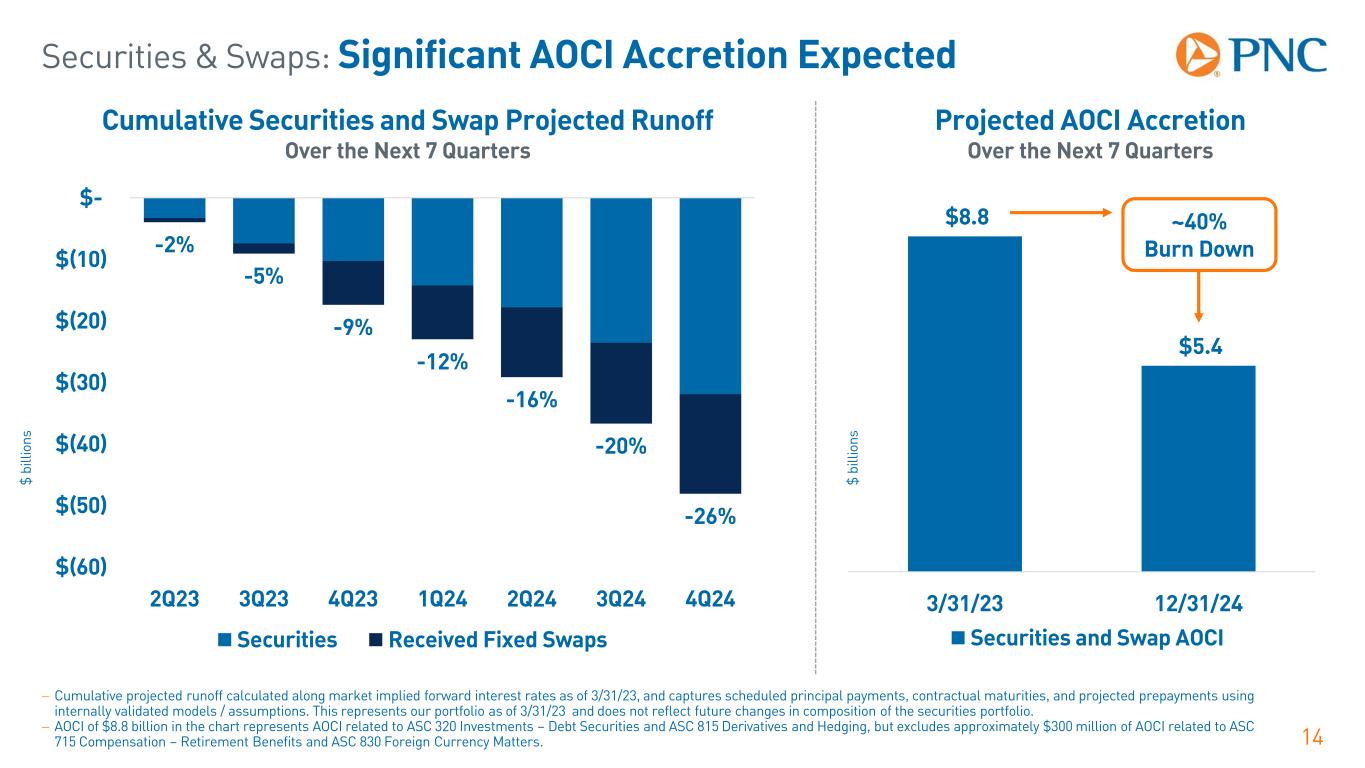
Securities & Swaps: Significant AOCI Accretion Expected 14 Cumulative Securities and Swap Projected Runoff Over the Next 7 Quarters -2% -5% -9% -12% -16% -20% -26% $(60) $(50) $(40) $(30) $(20) $(10) $- 2Q23 3Q23 4Q23 1Q24 2Q24 3Q24 4Q24 Securities Received Fixed Swaps Projected AOCI Accretion Over the Next 7 Quarters $8.8 $5.4 3/31/23 12/31/24 Securities and Swap AOCI − Cumulative projected runoff calculated along market implied forward interest rates as of 3/31/23, and captures scheduled principal payments, contractual maturities, and projected prepayments using internally validated models / assumptions. This represents our portfolio as of 3/31/23 and does not reflect future changes in composition of the securities portfolio. − AOCI of $8.8 billion in the chart represents AOCI related to ASC 320 Investments – Debt Securities and ASC 815 Derivatives and Hedging, but excludes approximately $300 million of AOCI related to ASC 715 Compensation – Retirement Benefits and ASC 830 Foreign Currency Matters. $ bi lli on s $ bi lli on s ~40% Burn Down
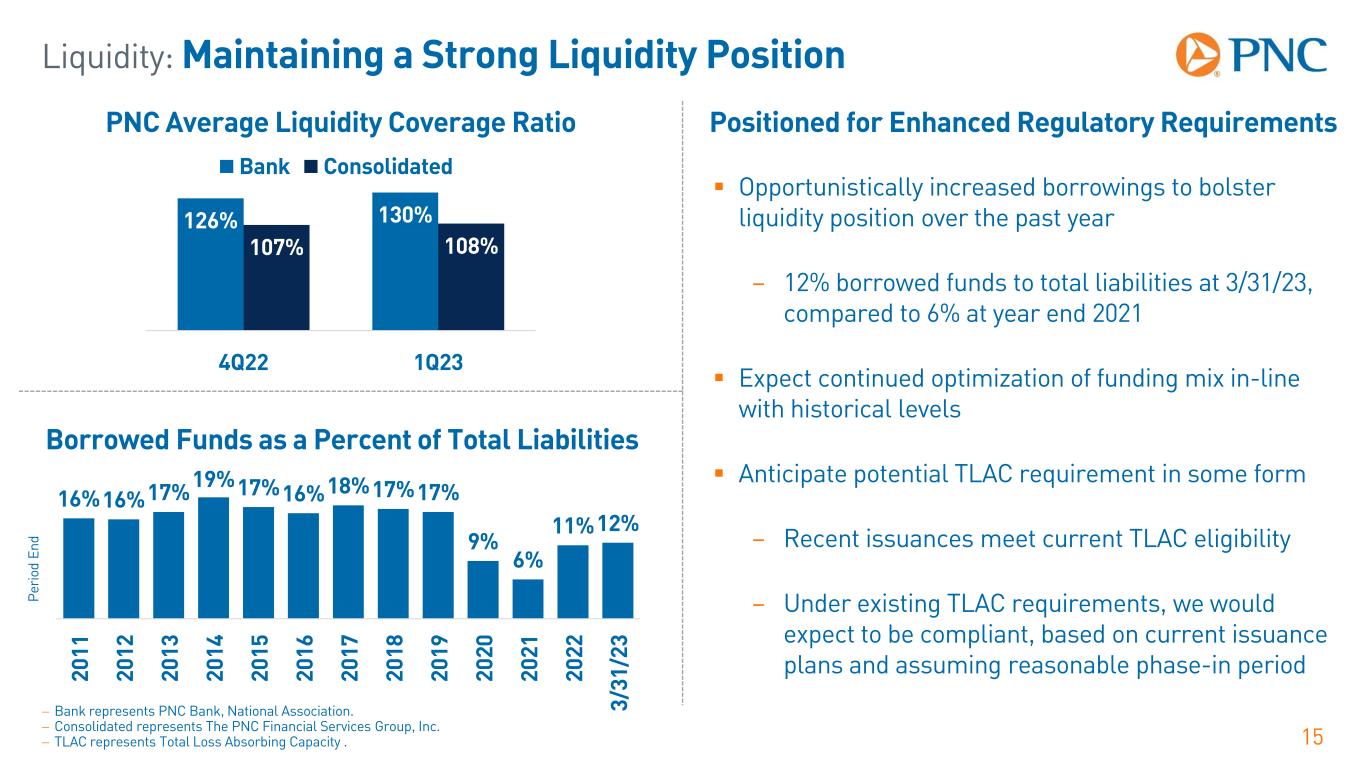
Liquidity: Maintaining a Strong Liquidity Position 15 PNC Average Liquidity Coverage Ratio P er io d En d − Bank represents PNC Bank, National Association. − Consolidated represents The PNC Financial Services Group, Inc. − TLAC represents Total Loss Absorbing Capacity . Positioned for Enhanced Regulatory Requirements Opportunistically increased borrowings to bolster liquidity position over the past year – 12% borrowed funds to total liabilities at 3/31/23, compared to 6% at year end 2021 Expect continued optimization of funding mix in-line with historical levels Anticipate potential TLAC requirement in some form – Recent issuances meet current TLAC eligibility – Under existing TLAC requirements, we would expect to be compliant, based on current issuance plans and assuming reasonable phase-in period 16%16%17%19%17%16%18%17%17% 9% 6% 11%12% 20 11 20 12 20 13 20 14 20 15 20 16 20 17 20 18 20 19 20 20 20 21 20 22 3/ 31 /2 3 Borrowed Funds as a Percent of Total Liabilities 126% 130% 107% 108% 4Q22 1Q23 Bank Consolidated
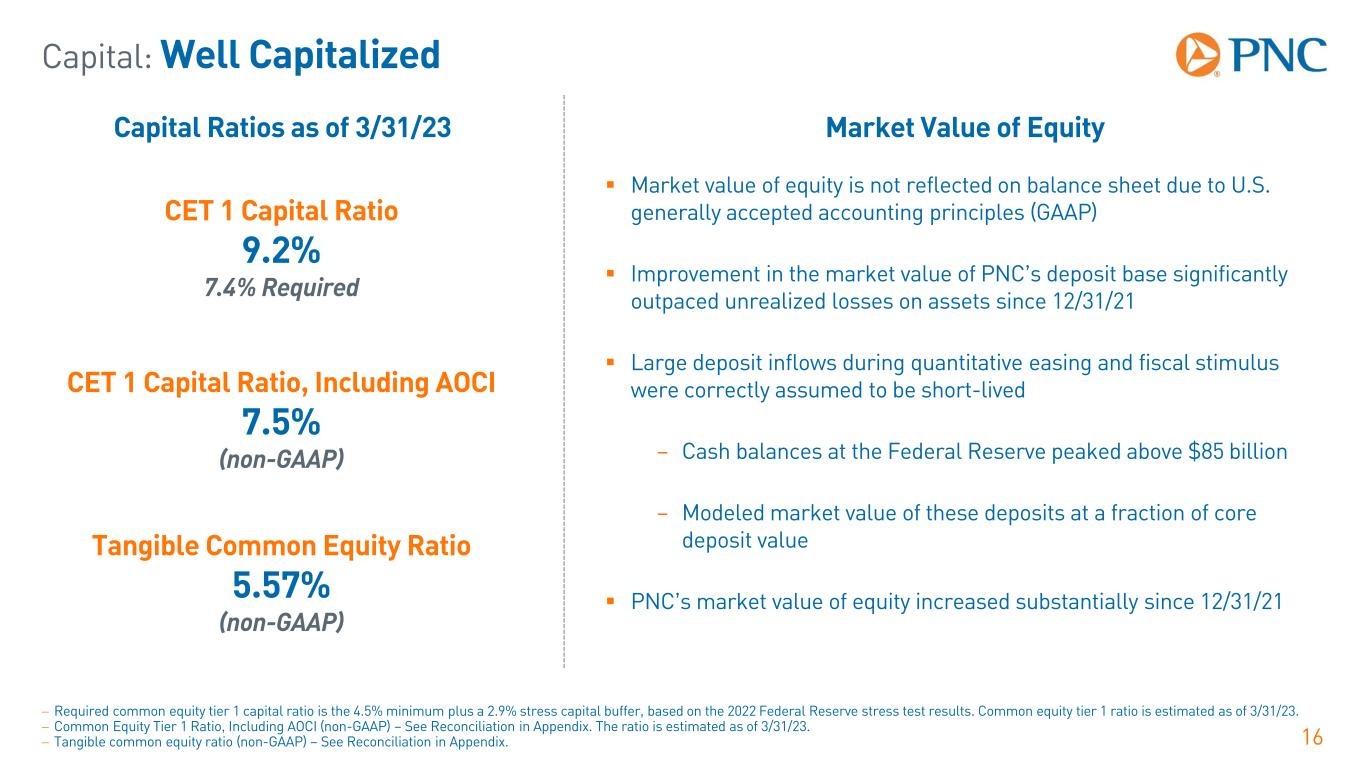
Capital: Well Capitalized 16 Capital Ratios as of 3/31/23 CET 1 Capital Ratio 9.2% 7.4% Required CET 1 Capital Ratio, Including AOCI 7.5% (non-GAAP) Tangible Common Equity Ratio 5.57% (non-GAAP) − Required common equity tier 1 capital ratio is the 4.5% minimum plus a 2.9% stress capital buffer, based on the 2022 Federal Reserve stress test results. Common equity tier 1 ratio is estimated as of 3/31/23. − Common Equity Tier 1 Ratio, Including AOCI (non-GAAP) – See Reconciliation in Appendix. The ratio is estimated as of 3/31/23. − Tangible common equity ratio (non-GAAP) – See Reconciliation in Appendix. Market value of equity is not reflected on balance sheet due to U.S. generally accepted accounting principles (GAAP) Improvement in the market value of PNC’s deposit base significantly outpaced unrealized losses on assets since 12/31/21 Large deposit inflows during quantitative easing and fiscal stimulus were correctly assumed to be short-lived – Cash balances at the Federal Reserve peaked above $85 billion – Modeled market value of these deposits at a fraction of core deposit value PNC’s market value of equity increased substantially since 12/31/21 Market Value of Equity

CRE Portfolio: Office Represents 2.7% of Total Loans 17 Non-Office CRE, 8.3% Office CRE, 2.7% Total $326 Billion PNC’s Commercial Real Estate (CRE) Portfolio Total Loans as of 3/31/23 $ billions 3/31/23 % of Total Loans Multifamily $14.3 4.4% Office 8.9 2.7% Industrial / Warehouse 3.9 1.2% Retail 2.8 0.9% Seniors Housing 2.0 0.6% Hotel / Motel 1.8 0.6% Mixed Use 0.6 0.2% Other 1.7 0.4% Total $36.0 11.0%
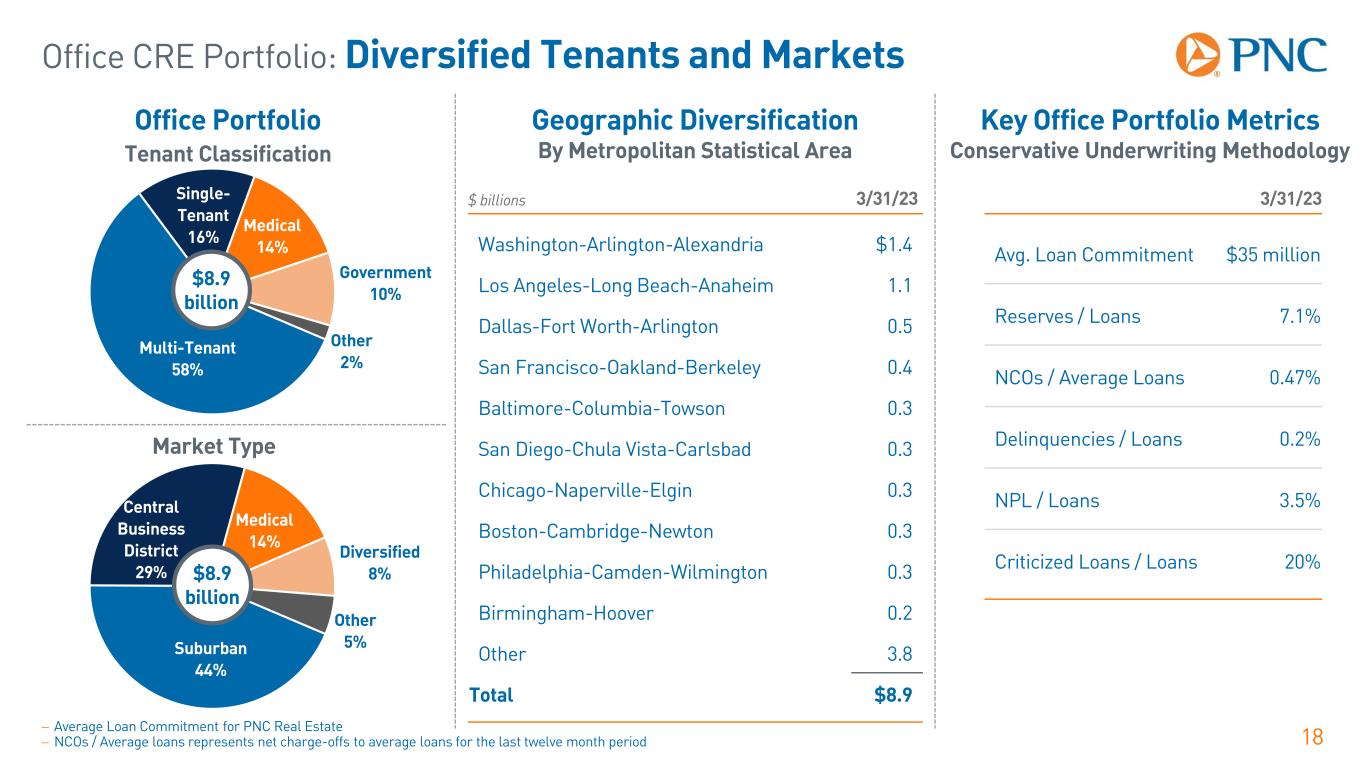
Office CRE Portfolio: Diversified Tenants and Markets 18 Office Portfolio Multi-Tenant 58% Single- Tenant 16% Medical 14% Government 10% Other 2% $8.9 billion Geographic Diversification By Metropolitan Statistical Area Key Office Portfolio Metrics Conservative Underwriting Methodology Suburban 44% Central Business District 29% Medical 14% Diversified 8% Other 5% $8.9 billion Tenant Classification Market Type $ billions 3/31/23 Washington-Arlington-Alexandria $1.4 Los Angeles-Long Beach-Anaheim 1.1 Dallas-Fort Worth-Arlington 0.5 San Francisco-Oakland-Berkeley 0.4 Baltimore-Columbia-Towson 0.3 San Diego-Chula Vista-Carlsbad 0.3 Chicago-Naperville-Elgin 0.3 Boston-Cambridge-Newton 0.3 Philadelphia-Camden-Wilmington 0.3 Birmingham-Hoover 0.2 Other 3.8 Total $8.9 3/31/23 Avg. Loan Commitment $35 million Reserves / Loans 7.1% NCOs / Average Loans 0.47% Delinquencies / Loans 0.2% NPL / Loans 3.5% Criticized Loans / Loans 20% − Average Loan Commitment for PNC Real Estate − NCOs / Average loans represents net charge-offs to average loans for the last twelve month period
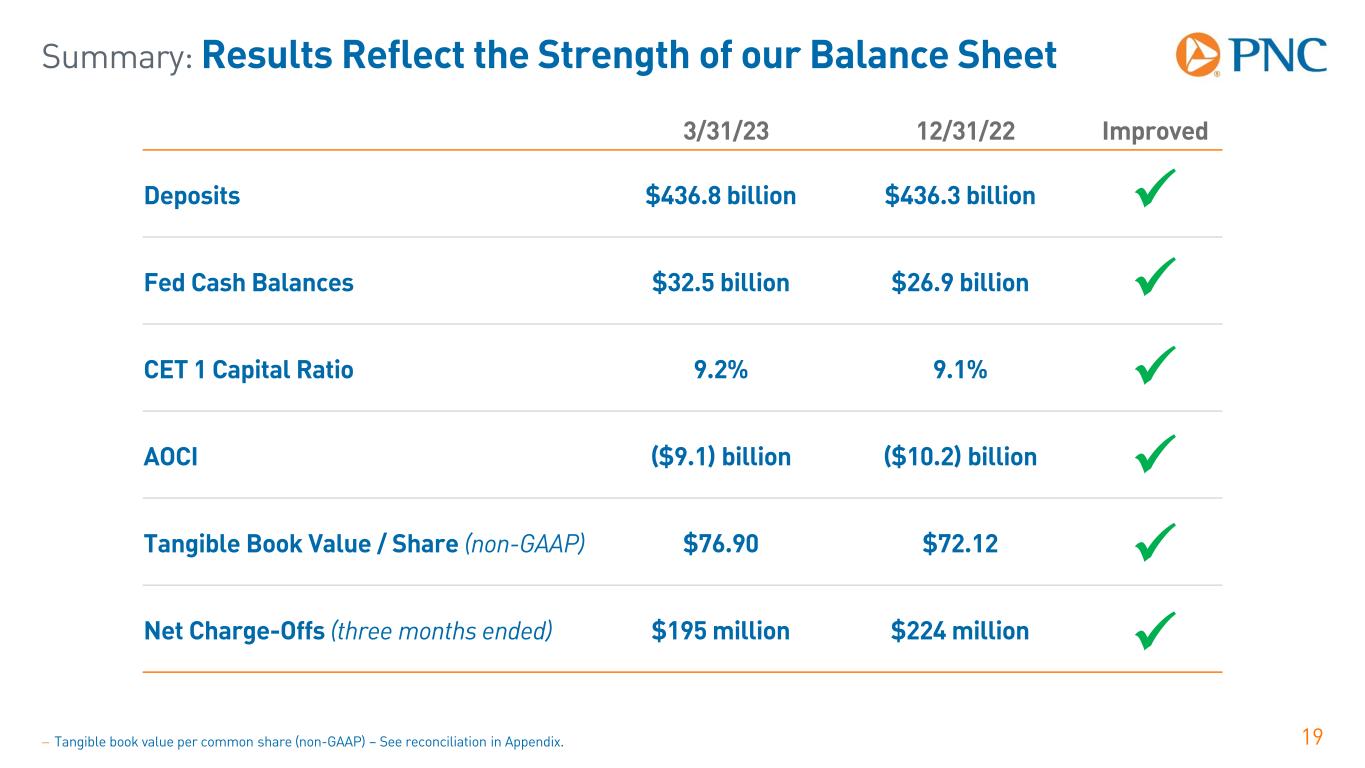
Summary: Results Reflect the Strength of our Balance Sheet 19 3/31/23 12/31/22 Improved Deposits $436.8 billion $436.3 billion Fed Cash Balances $32.5 billion $26.9 billion CET 1 Capital Ratio 9.2% 9.1% AOCI ($9.1) billion ($10.2) billion Tangible Book Value / Share (non-GAAP) $76.90 $72.12 Net Charge-Offs (three months ended) $195 million $224 million − Tangible book value per common share (non-GAAP) – See reconciliation in Appendix.
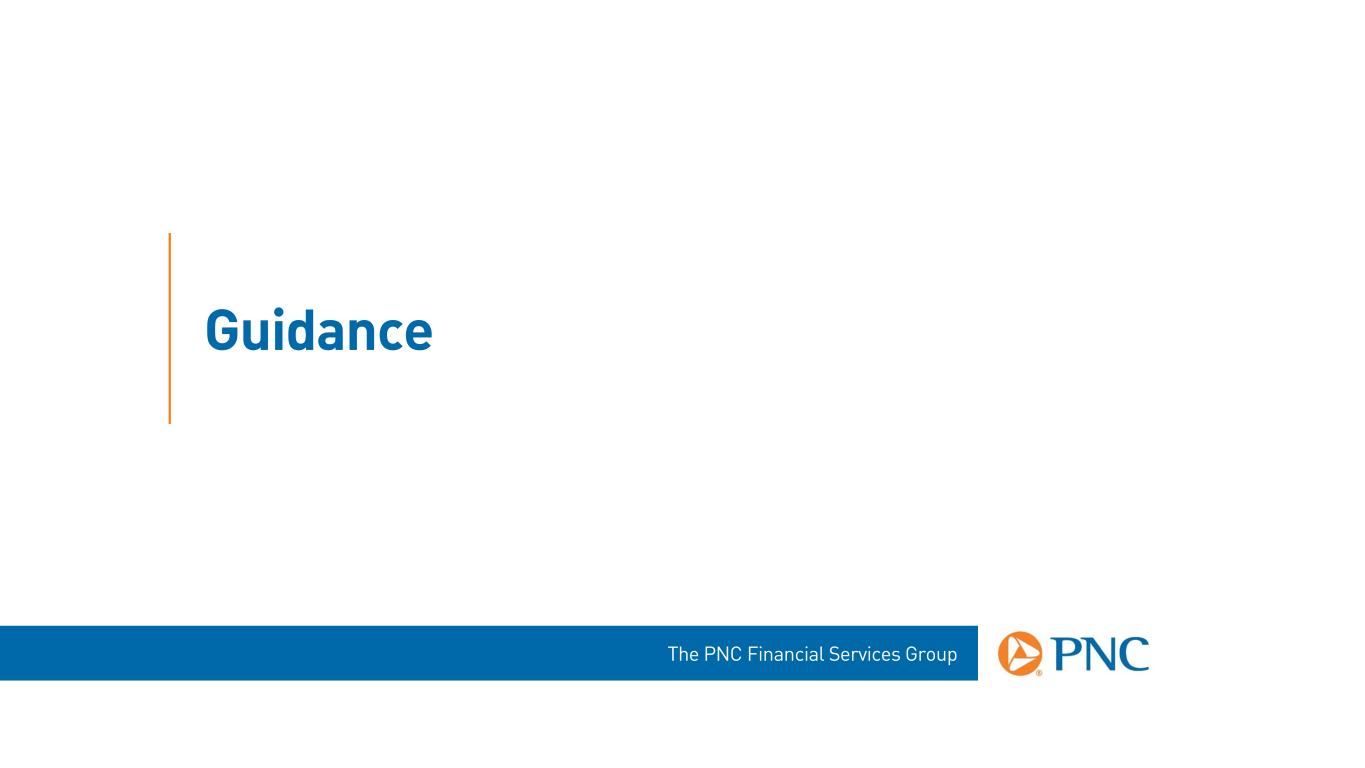
The PNC Financial Services Group Guidance
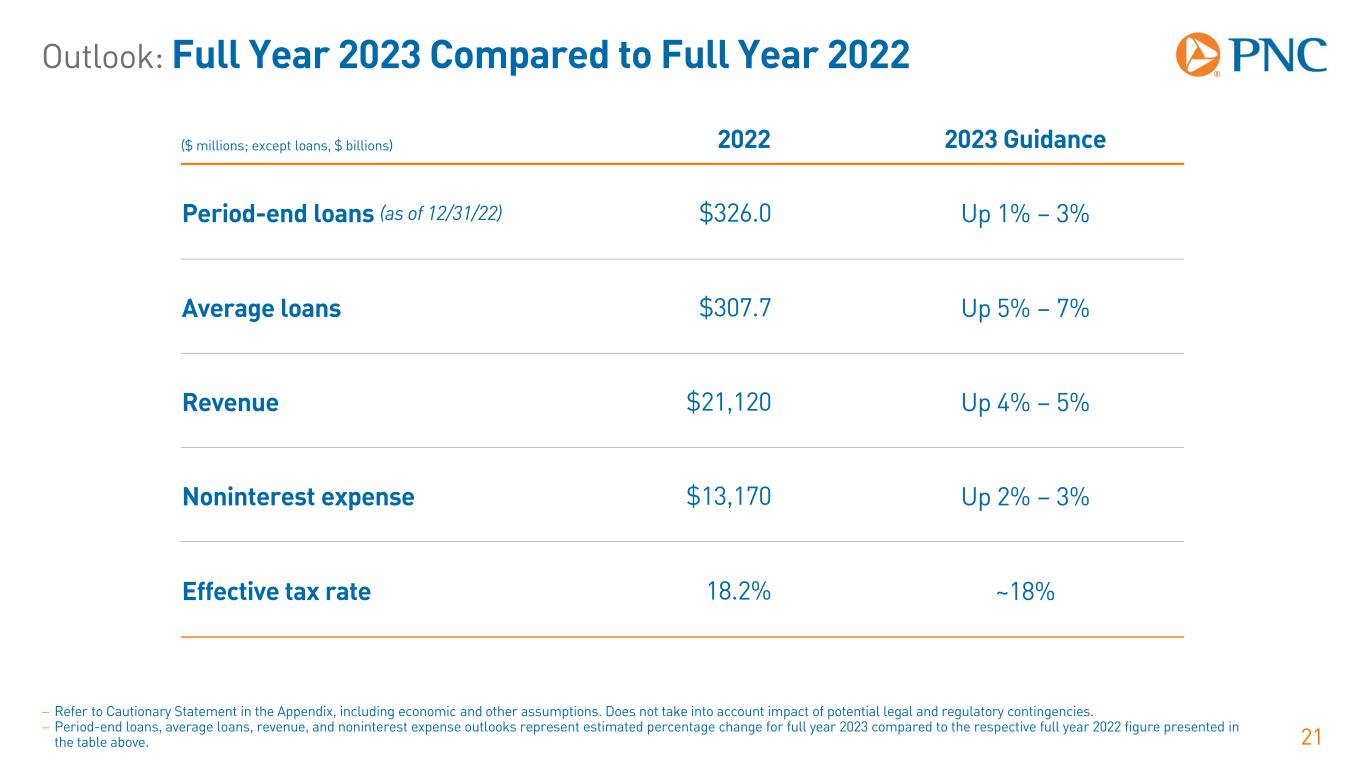
Outlook: Full Year 2023 Compared to Full Year 2022 21 − Refer to Cautionary Statement in the Appendix, including economic and other assumptions. Does not take into account impact of potential legal and regulatory contingencies. − Period-end loans, average loans, revenue, and noninterest expense outlooks represent estimated percentage change for full year 2023 compared to the respective full year 2022 figure presented in the table above. ($ millions; except loans, $ billions) 2022 2023 Guidance Period-end loans (as of 12/31/22) $326.0 Up 1% – 3% Average loans $307.7 Up 5% – 7% Revenue $21,120 Up 4% – 5% Noninterest expense $13,170 Up 2% – 3% Effective tax rate 18.2% ~18%
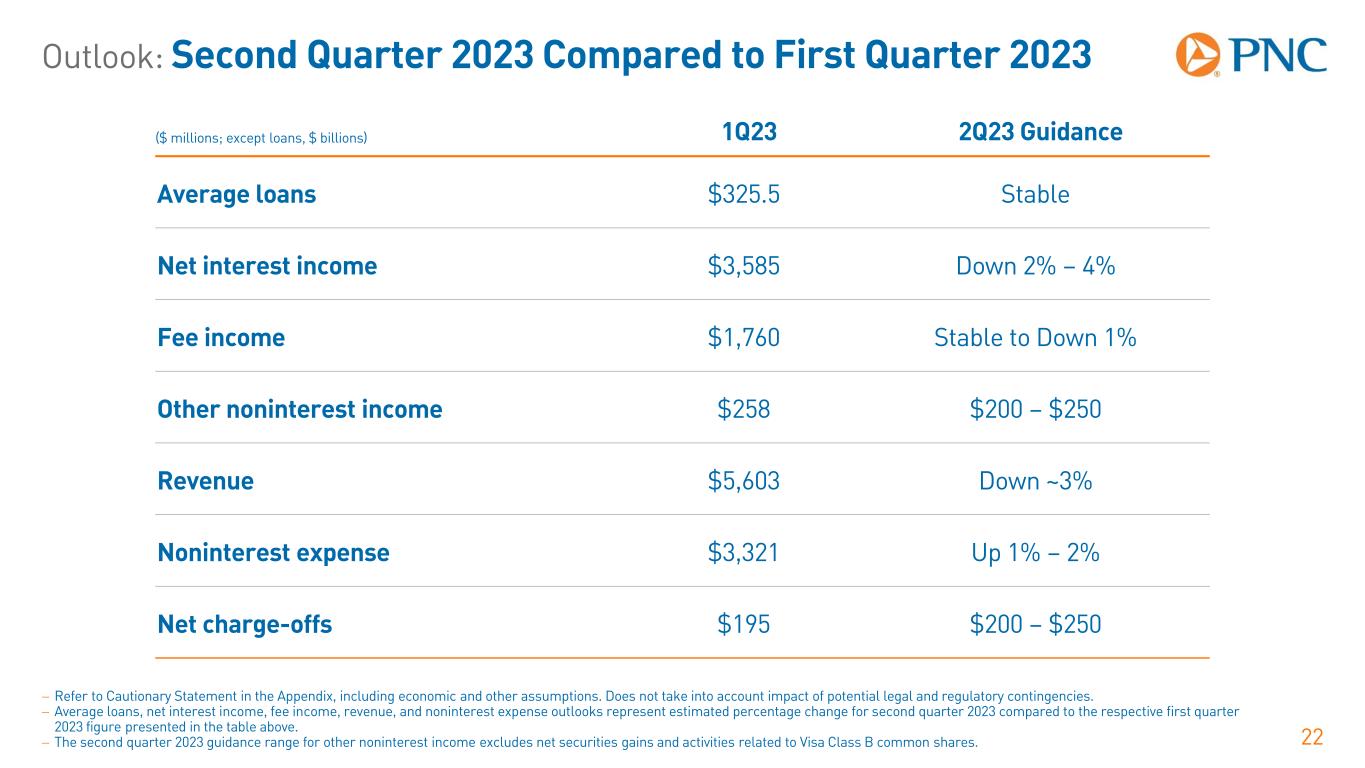
Outlook: Second Quarter 2023 Compared to First Quarter 2023 22 − Refer to Cautionary Statement in the Appendix, including economic and other assumptions. Does not take into account impact of potential legal and regulatory contingencies. − Average loans, net interest income, fee income, revenue, and noninterest expense outlooks represent estimated percentage change for second quarter 2023 compared to the respective first quarter 2023 figure presented in the table above. − The second quarter 2023 guidance range for other noninterest income excludes net securities gains and activities related to Visa Class B common shares. ($ millions; except loans, $ billions) 1Q23 2Q23 Guidance Average loans $325.5 Stable Net interest income $3,585 Down 2% – 4% Fee income $1,760 Stable to Down 1% Other noninterest income $258 $200 – $250 Revenue $5,603 Down ~3% Noninterest expense $3,321 Up 1% – 2% Net charge-offs $195 $200 – $250

Appendix: Cautionary Statement Regarding Forward-Looking Information 23 We make statements in this presentation, and we may from time to time make other statements, regarding our outlook for financial performance, such as earnings, revenues, expenses, tax rates, capital and liquidity levels and ratios, asset levels, asset quality, financial position, and other matters regarding or affecting us and our future business and operations, including our sustainability strategy, that are forward-looking statements within the meaning of the Private Securities Litigation Reform Act. Forward-looking statements are typically identified by words such as “believe,” “plan,” “expect,” “anticipate,” “see,” “look,” “intend,” “outlook,” “project,” “forecast,” “estimate,” “goal,” “will,” “should” and other similar words and expressions. Forward-looking statements are necessarily subject to numerous assumptions, risks and uncertainties, which change over time. Future events or circumstances may change our outlook and may also affect the nature of the assumptions, risks and uncertainties to which our forward-looking statements are subject. Forward-looking statements speak only as of the date made. We do not assume any duty and do not undertake any obligation to update forward-looking statements. Actual results or future events could differ, possibly materially, from those anticipated in forward-looking statements, as well as from historical performance. As a result, we caution against placing undue reliance on any forward-looking statements. Our forward-looking statements are subject to the following principal risks and uncertainties. Our businesses, financial results and balance sheet values are affected by business and economic conditions, including: − Changes in interest rates and valuations in debt, equity and other financial markets, − Disruptions in the U.S. and global financial markets, − Actions by the Federal Reserve Board, U.S. Treasury and other government agencies, including those that impact money supply, market interest rates and inflation, − Changes in customer behavior due to changing business and economic conditions or legislative or regulatory initiatives, − Changes in customers’, suppliers’ and other counterparties’ performance and creditworthiness, − Impacts of sanctions, tariffs and other trade policies of the U.S. and its global trading partners, − A continuation of recent turmoil in the banking industry, responsive measures to mitigate and manage it and related supervisory and regulatory actions and costs, − Impacts of changes in federal, state and local governmental policy, including on the regulatory landscape, capital markets, taxes, infrastructure spending and social programs, − PNC’s ability to attract, recruit and retain skilled employees, and − Commodity price volatility.
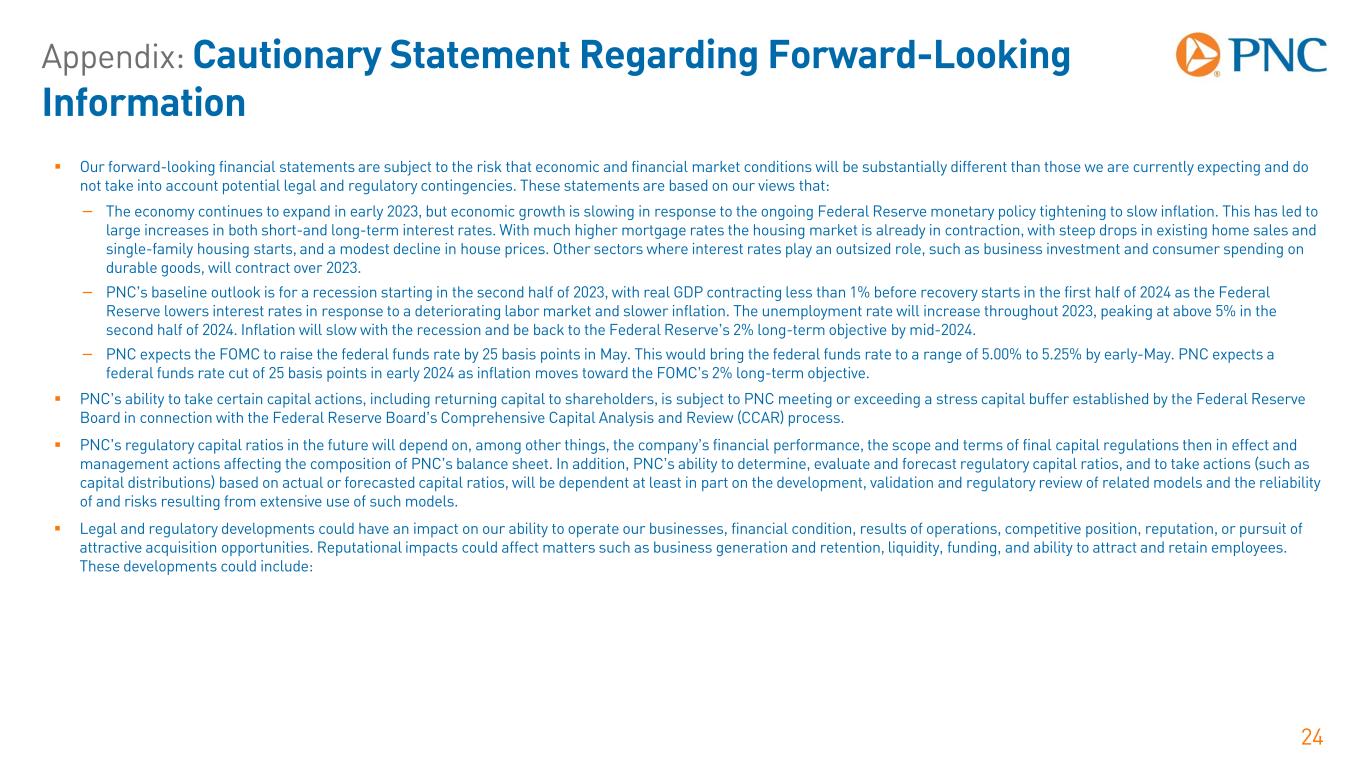
Appendix: Cautionary Statement Regarding Forward-Looking Information 24 Our forward-looking financial statements are subject to the risk that economic and financial market conditions will be substantially different than those we are currently expecting and do not take into account potential legal and regulatory contingencies. These statements are based on our views that: − The economy continues to expand in early 2023, but economic growth is slowing in response to the ongoing Federal Reserve monetary policy tightening to slow inflation. This has led to large increases in both short-and long-term interest rates. With much higher mortgage rates the housing market is already in contraction, with steep drops in existing home sales and single-family housing starts, and a modest decline in house prices. Other sectors where interest rates play an outsized role, such as business investment and consumer spending on durable goods, will contract over 2023. − PNC’s baseline outlook is for a recession starting in the second half of 2023, with real GDP contracting less than 1% before recovery starts in the first half of 2024 as the Federal Reserve lowers interest rates in response to a deteriorating labor market and slower inflation. The unemployment rate will increase throughout 2023, peaking at above 5% in the second half of 2024. Inflation will slow with the recession and be back to the Federal Reserve’s 2% long-term objective by mid-2024. − PNC expects the FOMC to raise the federal funds rate by 25 basis points in May. This would bring the federal funds rate to a range of 5.00% to 5.25% by early-May. PNC expects a federal funds rate cut of 25 basis points in early 2024 as inflation moves toward the FOMC’s 2% long-term objective. PNC’s ability to take certain capital actions, including returning capital to shareholders, is subject to PNC meeting or exceeding a stress capital buffer established by the Federal Reserve Board in connection with the Federal Reserve Board’s Comprehensive Capital Analysis and Review (CCAR) process. PNC’s regulatory capital ratios in the future will depend on, among other things, the company’s financial performance, the scope and terms of final capital regulations then in effect and management actions affecting the composition of PNC’s balance sheet. In addition, PNC’s ability to determine, evaluate and forecast regulatory capital ratios, and to take actions (such as capital distributions) based on actual or forecasted capital ratios, will be dependent at least in part on the development, validation and regulatory review of related models and the reliability of and risks resulting from extensive use of such models. Legal and regulatory developments could have an impact on our ability to operate our businesses, financial condition, results of operations, competitive position, reputation, or pursuit of attractive acquisition opportunities. Reputational impacts could affect matters such as business generation and retention, liquidity, funding, and ability to attract and retain employees. These developments could include:
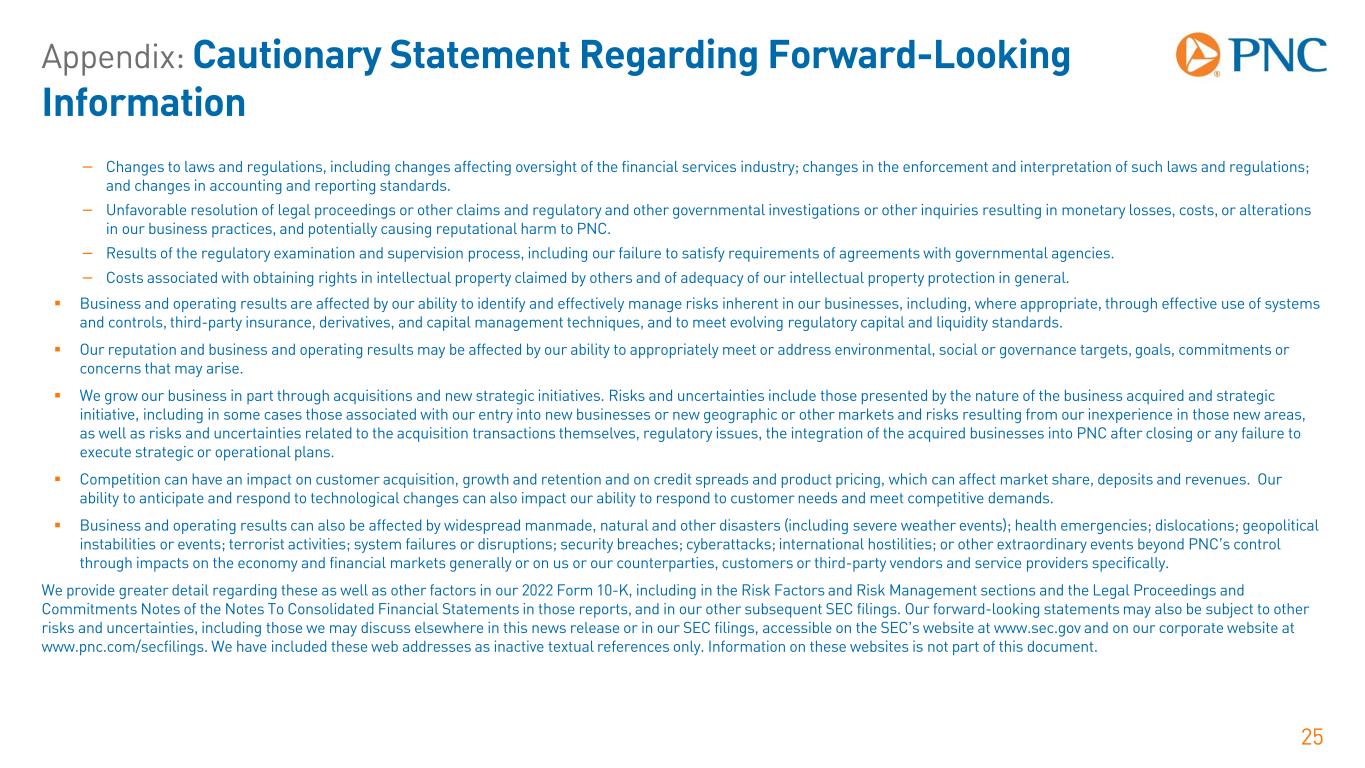
Appendix: Cautionary Statement Regarding Forward-Looking Information 25 − Changes to laws and regulations, including changes affecting oversight of the financial services industry; changes in the enforcement and interpretation of such laws and regulations; and changes in accounting and reporting standards. − Unfavorable resolution of legal proceedings or other claims and regulatory and other governmental investigations or other inquiries resulting in monetary losses, costs, or alterations in our business practices, and potentially causing reputational harm to PNC. − Results of the regulatory examination and supervision process, including our failure to satisfy requirements of agreements with governmental agencies. − Costs associated with obtaining rights in intellectual property claimed by others and of adequacy of our intellectual property protection in general. Business and operating results are affected by our ability to identify and effectively manage risks inherent in our businesses, including, where appropriate, through effective use of systems and controls, third-party insurance, derivatives, and capital management techniques, and to meet evolving regulatory capital and liquidity standards. Our reputation and business and operating results may be affected by our ability to appropriately meet or address environmental, social or governance targets, goals, commitments or concerns that may arise. We grow our business in part through acquisitions and new strategic initiatives. Risks and uncertainties include those presented by the nature of the business acquired and strategic initiative, including in some cases those associated with our entry into new businesses or new geographic or other markets and risks resulting from our inexperience in those new areas, as well as risks and uncertainties related to the acquisition transactions themselves, regulatory issues, the integration of the acquired businesses into PNC after closing or any failure to execute strategic or operational plans. Competition can have an impact on customer acquisition, growth and retention and on credit spreads and product pricing, which can affect market share, deposits and revenues. Our ability to anticipate and respond to technological changes can also impact our ability to respond to customer needs and meet competitive demands. Business and operating results can also be affected by widespread manmade, natural and other disasters (including severe weather events); health emergencies; dislocations; geopolitical instabilities or events; terrorist activities; system failures or disruptions; security breaches; cyberattacks; international hostilities; or other extraordinary events beyond PNC’s control through impacts on the economy and financial markets generally or on us or our counterparties, customers or third-party vendors and service providers specifically. We provide greater detail regarding these as well as other factors in our 2022 Form 10-K, including in the Risk Factors and Risk Management sections and the Legal Proceedings and Commitments Notes of the Notes To Consolidated Financial Statements in those reports, and in our other subsequent SEC filings. Our forward-looking statements may also be subject to other risks and uncertainties, including those we may discuss elsewhere in this news release or in our SEC filings, accessible on the SEC’s website at www.sec.gov and on our corporate website at www.pnc.com/secfilings. We have included these web addresses as inactive textual references only. Information on these websites is not part of this document.
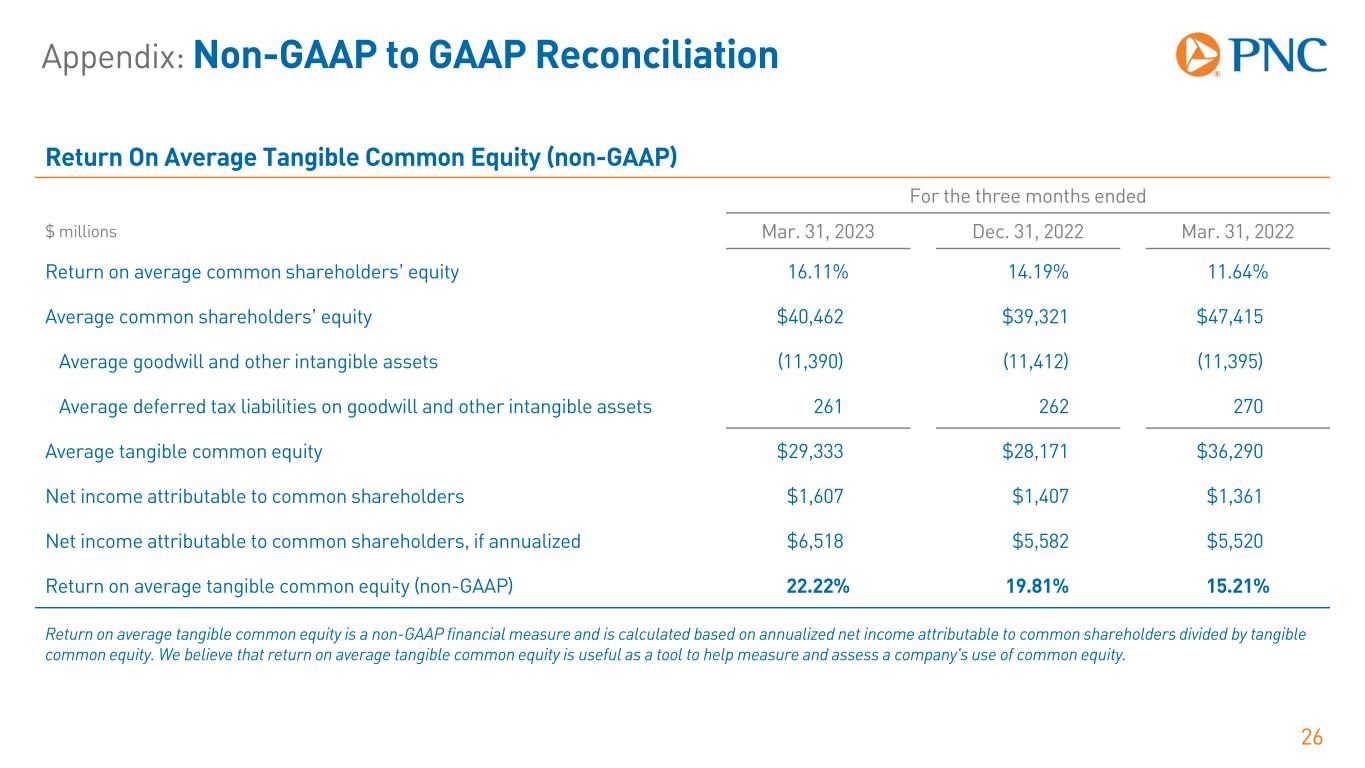
Appendix: Non-GAAP to GAAP Reconciliation 26 Return On Average Tangible Common Equity (non-GAAP) For the three months ended $ millions Mar. 31, 2023 Dec. 31, 2022 Mar. 31, 2022 Return on average common shareholders’ equity 16.11% 14.19% 11.64% Average common shareholders’ equity $40,462 $39,321 $47,415 Average goodwill and other intangible assets (11,390) (11,412) (11,395) Average deferred tax liabilities on goodwill and other intangible assets 261 262 270 Average tangible common equity $29,333 $28,171 $36,290 Net income attributable to common shareholders $1,607 $1,407 $1,361 Net income attributable to common shareholders, if annualized $6,518 $5,582 $5,520 Return on average tangible common equity (non-GAAP) 22.22% 19.81% 15.21% Return on average tangible common equity is a non-GAAP financial measure and is calculated based on annualized net income attributable to common shareholders divided by tangible common equity. We believe that return on average tangible common equity is useful as a tool to help measure and assess a company's use of common equity.

Appendix: Non-GAAP to GAAP Reconciliation 27 Pretax, Pre-Provision Earnings (non-GAAP) For the three months ended $ millions Mar. 31, 2023 Dec. 31, 2022 Mar. 31, 2022 Net interest income $3,585 $3,684 $2,804 Noninterest income 2,018 2,079 1,888 Total Revenue $5,603 $5,763 $4,692 Noninterest expense 3,321 3,474 3,172 Pretax, pre-provision earnings $2,282 $2,289 $1,520 We believe that pretax, pre-provision earnings is a useful tool to help evaluate the ability to provide for credit costs through operations and provides an additional basis to compare results between periods by isolating the impact of provision for (recapture of) credit losses, which can vary significantly between periods.

Appendix: Non-GAAP to GAAP Reconciliation 28 Taxable-Equivalent Net Interest Income (non-GAAP) For the three months ended $ millions Mar. 31, 2023 Dec. 31, 2022 Sept. 30, 2022 June 30, 2022 Mar. 31, 2022 Net interest income $3,585 $3,684 $3,475 $3,051 $2,804 Taxable-equivalent adjustments 38 36 29 25 22 Net interest income - fully taxable-equivalent (non-GAAP) $3,623 $3,720 $3,504 $3,076 $2,826 The interest income earned on certain earning assets is completely or partially exempt from federal income tax. As such, these tax-exempt instruments typically yield lower returns than taxable investments. To provide more meaningful comparisons of net interest income, we use interest income on a taxable-equivalent basis by increasing the interest income earned on tax-exempt assets to make it fully equivalent to interest income earned on taxable investments. This adjustment is not permitted under GAAP. Taxable equivalent net interest income is only used for calculating net interest margin and net interest income shown elsewhere in this presentation is GAAP net interest income.
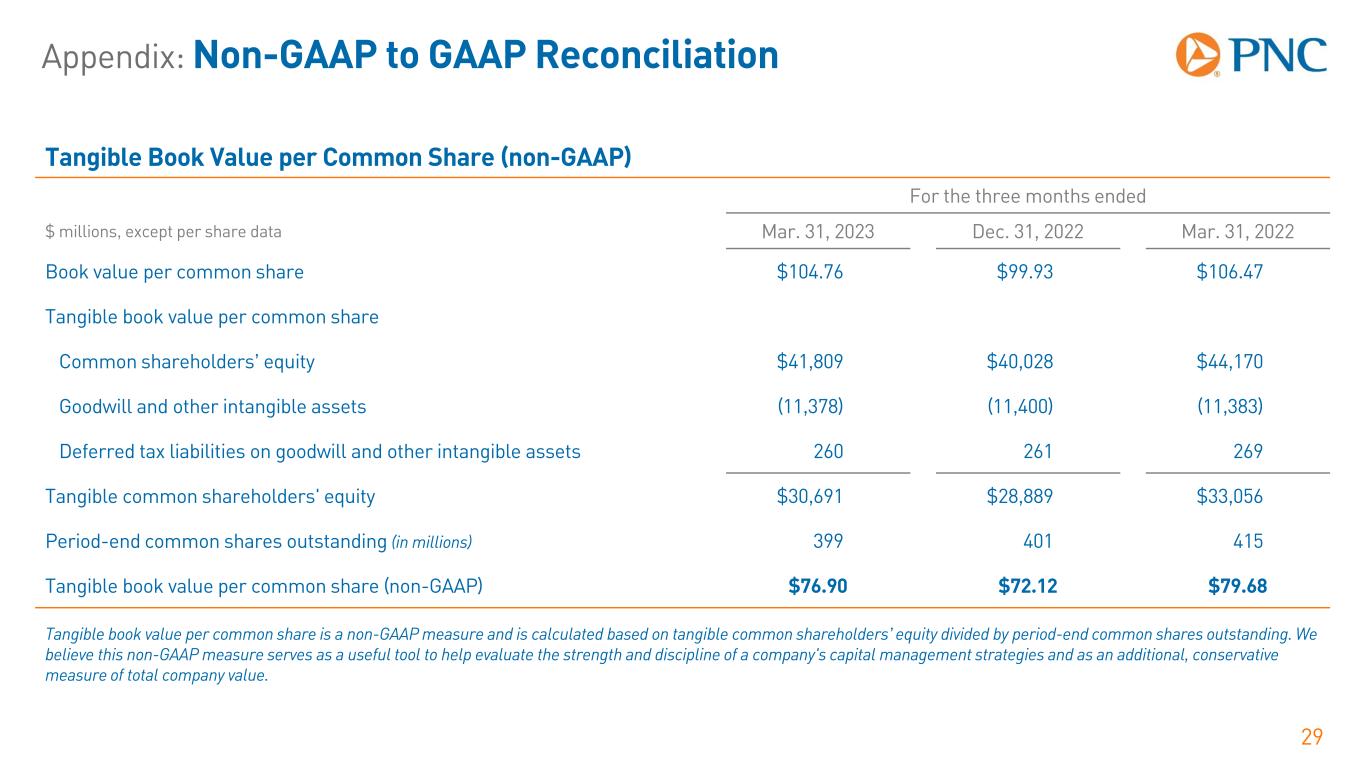
Appendix: Non-GAAP to GAAP Reconciliation 29 Tangible Book Value per Common Share (non-GAAP) For the three months ended $ millions, except per share data Mar. 31, 2023 Dec. 31, 2022 Mar. 31, 2022 Book value per common share $104.76 $99.93 $106.47 Tangible book value per common share Common shareholders’ equity $41,809 $40,028 $44,170 Goodwill and other intangible assets (11,378) (11,400) (11,383) Deferred tax liabilities on goodwill and other intangible assets 260 261 269 Tangible common shareholders' equity $30,691 $28,889 $33,056 Period-end common shares outstanding (in millions) 399 401 415 Tangible book value per common share (non-GAAP) $76.90 $72.12 $79.68 Tangible book value per common share is a non-GAAP measure and is calculated based on tangible common shareholders’ equity divided by period-end common shares outstanding. We believe this non-GAAP measure serves as a useful tool to help evaluate the strength and discipline of a company's capital management strategies and as an additional, conservative measure of total company value.
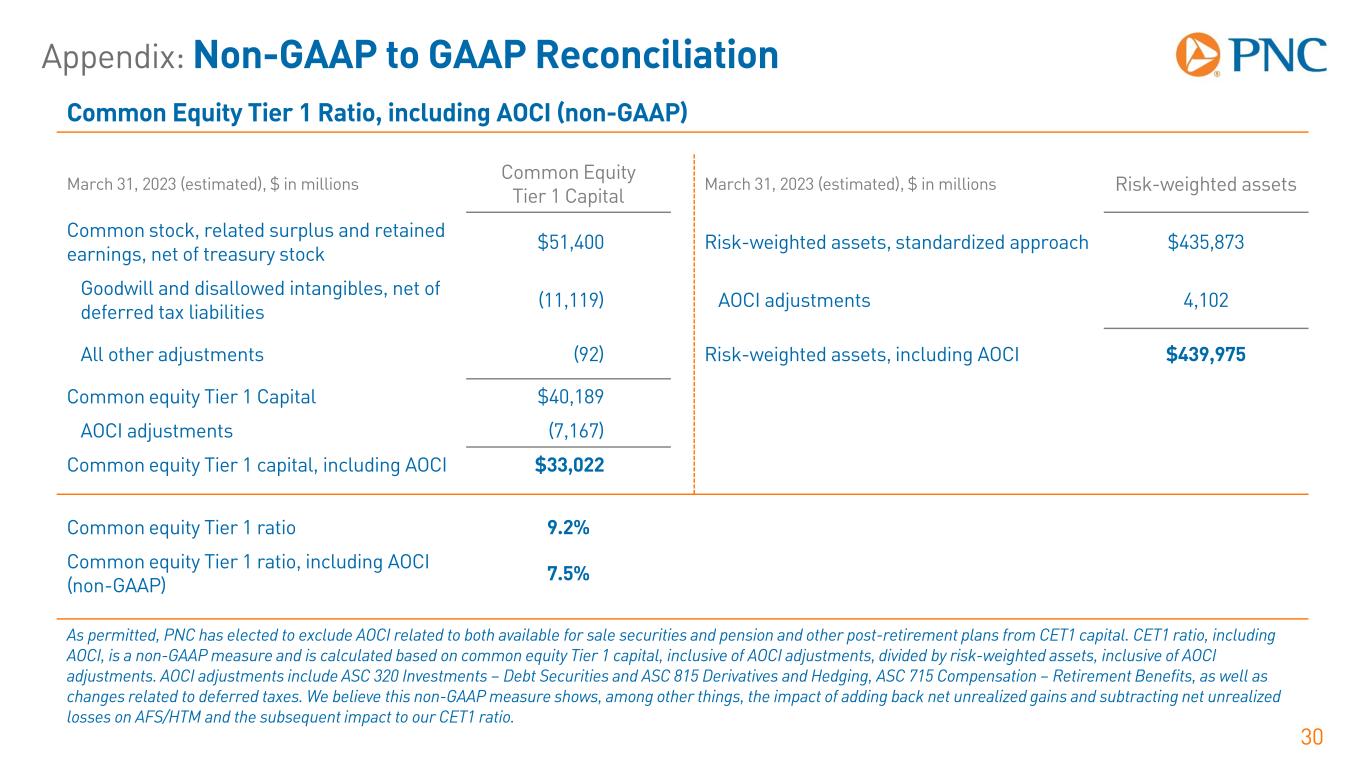
Appendix: Non-GAAP to GAAP Reconciliation 30 Common Equity Tier 1 Ratio, including AOCI (non-GAAP) March 31, 2023 (estimated), $ in millions Common Equity Tier 1 Capital March 31, 2023 (estimated), $ in millions Risk-weighted assets Common stock, related surplus and retained earnings, net of treasury stock $51,400 Risk-weighted assets, standardized approach $435,873 Goodwill and disallowed intangibles, net of deferred tax liabilities (11,119) AOCI adjustments 4,102 All other adjustments (92) Risk-weighted assets, including AOCI $439,975 Common equity Tier 1 Capital $40,189 AOCI adjustments (7,167) Common equity Tier 1 capital, including AOCI $33,022 Common equity Tier 1 ratio 9.2% Common equity Tier 1 ratio, including AOCI (non-GAAP) 7.5% As permitted, PNC has elected to exclude AOCI related to both available for sale securities and pension and other post-retirement plans from CET1 capital. CET1 ratio, including AOCI, is a non-GAAP measure and is calculated based on common equity Tier 1 capital, inclusive of AOCI adjustments, divided by risk-weighted assets, inclusive of AOCI adjustments. AOCI adjustments include ASC 320 Investments – Debt Securities and ASC 815 Derivatives and Hedging, ASC 715 Compensation – Retirement Benefits, as well as changes related to deferred taxes. We believe this non-GAAP measure shows, among other things, the impact of adding back net unrealized gains and subtracting net unrealized losses on AFS/HTM and the subsequent impact to our CET1 ratio.

Appendix: Non-GAAP to GAAP Reconciliation 31 Tangible Common Equity Ratio (non-GAAP) For the three months ended $ millions Mar. 31, 2023 Tangible common shareholders’ equity Common shareholders’ equity $41,809 Goodwill and other intangible assets (11,378) Deferred tax liabilities on goodwill and other intangible assets 260 Tangible common shareholders' equity $30,691 Tangible assets Total assets $561,777 Goodwill and other intangible assets (11,378) Deferred tax liabilities on goodwill and other intangible assets 260 Tangible assets $550,659 Tangible common equity ratio (non-GAAP) 5.57% Tangible common equity ratio is a non-GAAP measure and is calculated based on tangible common shareholders’ equity divided by tangible assets. We believe this non-GAAP measure to be a key financial metric in assessing capital adequacy.
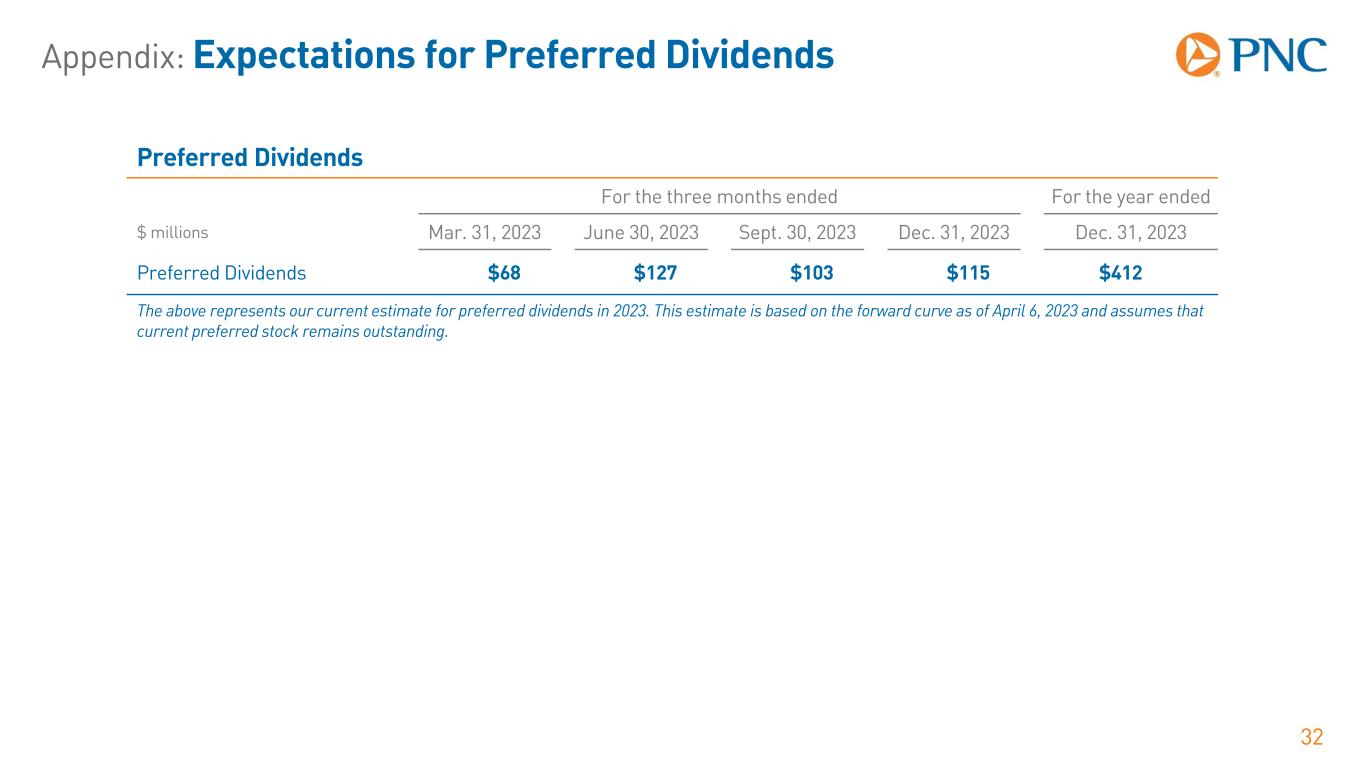
Appendix: Expectations for Preferred Dividends 32 Preferred Dividends For the three months ended For the year ended $ millions Mar. 31, 2023 June 30, 2023 Sept. 30, 2023 Dec. 31, 2023 Dec. 31, 2023 Preferred Dividends $68 $127 $103 $115 $412 The above represents our current estimate for preferred dividends in 2023. This estimate is based on the forward curve as of April 6, 2023 and assumes that current preferred stock remains outstanding.